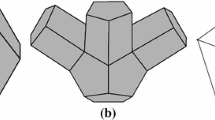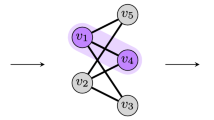Abstract
We study the lion-and-man game in which a lion (the pursuer) tries to capture a man (the evader). The players have equal speed and they can observe each other at all times. In this paper, we study the game on surfaces of convex terrains. We show that the lion can capture the man in finite number of steps determined by the terrain geometry.
Access this chapter
Tax calculation will be finalised at checkout
Purchases are for personal use only
Similar content being viewed by others
Notes
- 1.
This includes the entire time interval in one step.
References
Chung, T., Hollinger, G., Isler, V.: Search and pursuit-evasion in mobile robotics. Auton. Robot. 3, (2011)
Littlewood, J.E.: A Mathematician’s Miscellany. Methuen, London (1953)
Alonso, L., Goldstein, A.S., Reingold, E.M.: Lion and man: upper and lower bounds. INFORMS J. Comput. 4(4), 447 (1992)
Isler, V., Kannan, S., Khanna, S.: Randomized pursuit-evasion in a polygonal environment. IEEE Trans. Robot. 21(5), 875–884 (2005)
Bhadauria, D., Klein, K., Isler, V., Suri, S.: Capturing an evader in polygonal environments with obstacles: the full visibility case. Int. J. Robot. Res. (2012)
Guibas, L.J., Latombe, J.-C., Lavalle, S.M., Lin, D., Motwani, R.: A visibility-based pursuit-evasion problem. Int. J. Comput. Geom. Appl. 9(4–5), 471–493 (1999)
Adler, M., Rcke, H., Sivadasan, N., Sohler, C., Vcking, B.: Randomized pursuit-evasion in graphs. In: Widmayer, P., Eidenbenz, S., Triguero, F., Morales, R., Conejo, R., Hennessy, M. (eds.) Automata, Languages and Programming, Series Lecture Notes in Computer Science. vol. 2380, pp. 901–912, Springer, Berlin (2002)
Kopparty, S., Ravishankar, C.V.: A framework for pursuit evasion games in rn. Inform. Process. Lett. 96(3), 114–122 (2005)
Alexander, S., Bishop, R., Ghrist, R.: Pursuit and evasion in non-convex domains of arbitrary dimensions. In: Robotics: Science and Systems. Citeseer (2006)
Klein, K., Suri, S.: Pursuit evasion on polyhedral surfaces. In: Cai, L., Cheng, S.-W., Lam, T.-W. (eds.) Algorithms and Computation, Series Lecture Notes in Computer Science, vol. 8283, pp. 284–294. Springer, Berlin (2013)
Noori, N., Isler, V.: The lion and man game on polyhedral surfaces with boundary. In: IEEE Conference on Intelligent Robots and Systems (IROS) (2014)
Noori, N., Isler, V.: The lion and man game on convex terrains. Department of Computer Science & Engineering, University of Minnesota. Technical Report 13-026 (2013)
Eidenbenz, S., Stamm, C., Widmayer, P.: In: approximability results for guarding polygons and terrains. Algorithmica 31(1), 79–113 (2001)
Author information
Authors and Affiliations
Corresponding author
Editor information
Editors and Affiliations
Appendix
Appendix
Remark 1
In the following proofs, we treat the disappearing vertex event as a no vertex event with edge length zero for the disappearing edges.
Lemma 8
Let \(W_1\) and \(W_2\) be two consecutive wavefronts, and \(e\) be a point outside \(W^i\) in the \(XY\)-plane. Suppose that \(e\) is in the edge region of an edge \(m_1\) in \(W_1\). Then, the distance between \(p_1\), the image of the projection of \(e\) onto \(W_1\), and \(p_2\), the image of the projection of \(e\) onto \(W_2\), is less than \(D\) where \(D\) is the maximum distance between any two wavefronts in the \(XY\)-plane [12].
Lemma 9
Let \(W_1\) and \(W_2\) be two consecutive wavefronts, and \(e\) be a point outside \(W^i\) in the \(XY\)-plane. Suppose that \(e\) is in the wedge region of a vertex \(w_1\) in \(W_1\). Then, the distance between \(p_1 = w_1^i\), the image of the projection of \(e\) onto \(W_1\), and \(p_2\), the image of the projection of \(e\) onto \(W_2\), is less than \(D\) where \(D\) is the maximum distance between any two wavefronts in the \(XY\)-plane [12].
Lemma 10
Consider the image of a wavefront \(W\) in the \(XY\)-plane. Let \(e\) be a point in the \(XY\)-plane which is outside \(W^i\). Let \(p\) be the projection of \(e\) onto \(W^i\). The line segment \(ep\) makes two angles with \(W^i\). Then both of these angles are larger than \(\frac{\pi }{2}\) [12].
Lemma 11
Consider the image of a wavefront \(W\) onto the \(XY\)-plane, i.e. \(W^i\). Let \(e_1\) be a point in the \(XY\)-plane which is outside the region enclosed by \(W^i\). Moreover, let \(e\) denote the projection of \(e_1\) onto \(W^i\) ( i.e. \(\pi (e_1,W)\), see Definition 7). Then, for all points \(q \in W^i\), we have [12]:
-
In the \(XY\)-plane, \(e\) is closer to \(q\) than \(e_1\). We show this by proving that \(d_{W}(e, q) \le d_{XY}(e_1,q)\).
-
In the \(XY\)-plane, \(e\) is closer to \(e_1\) than any other point \(q\) on \(W^i\). In other words, \(d_{XY}(e,e_1) \le d_{XY}(q,e_1)\).
Rights and permissions
Copyright information
© 2015 Springer International Publishing Switzerland
About this chapter
Cite this chapter
Noori, N., Isler, V. (2015). The Lion and Man Game on Convex Terrains. In: Akin, H., Amato, N., Isler, V., van der Stappen, A. (eds) Algorithmic Foundations of Robotics XI. Springer Tracts in Advanced Robotics, vol 107. Springer, Cham. https://doi.org/10.1007/978-3-319-16595-0_26
Download citation
DOI: https://doi.org/10.1007/978-3-319-16595-0_26
Published:
Publisher Name: Springer, Cham
Print ISBN: 978-3-319-16594-3
Online ISBN: 978-3-319-16595-0
eBook Packages: EngineeringEngineering (R0)




